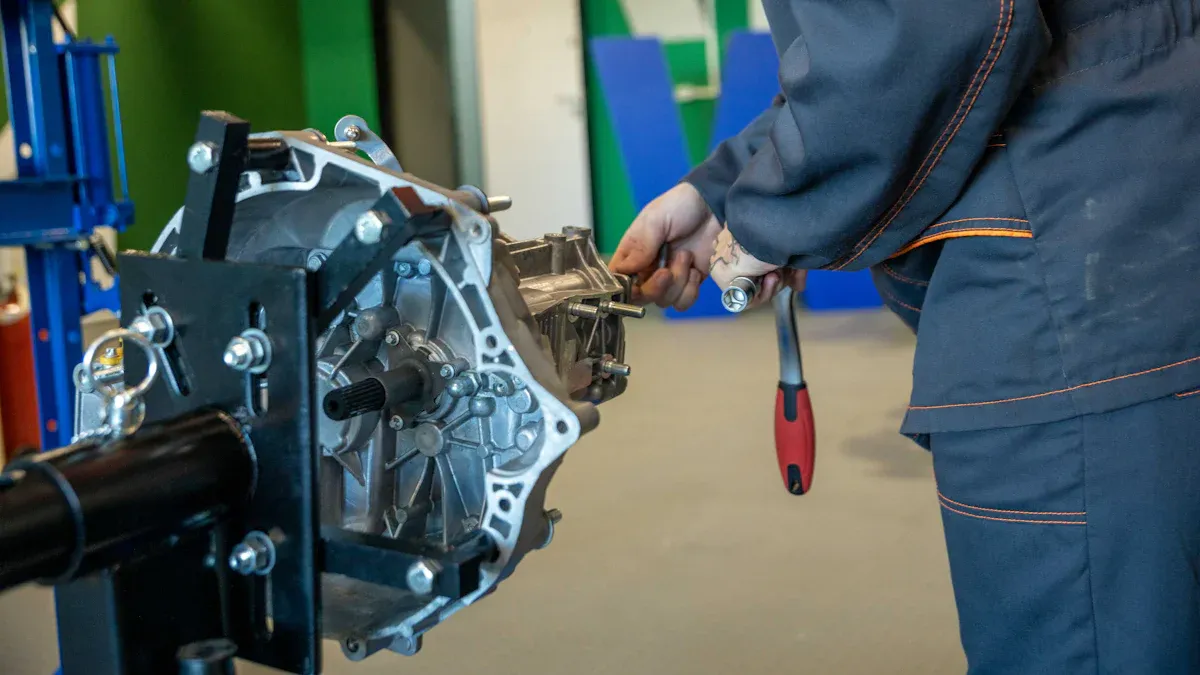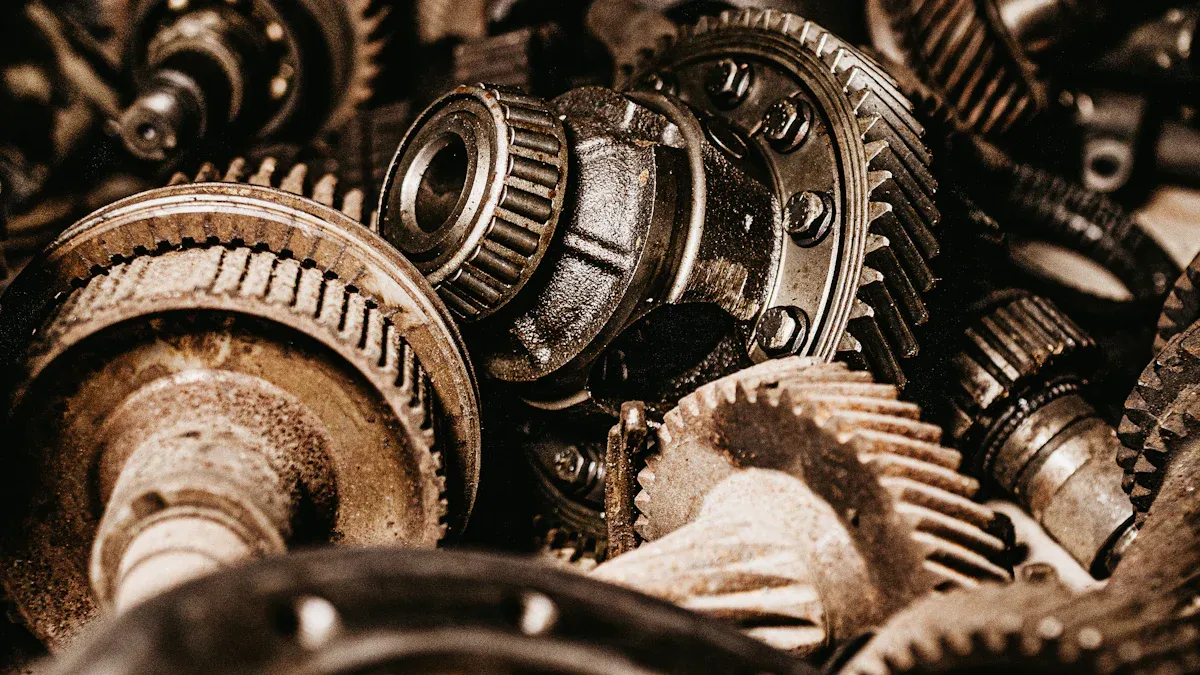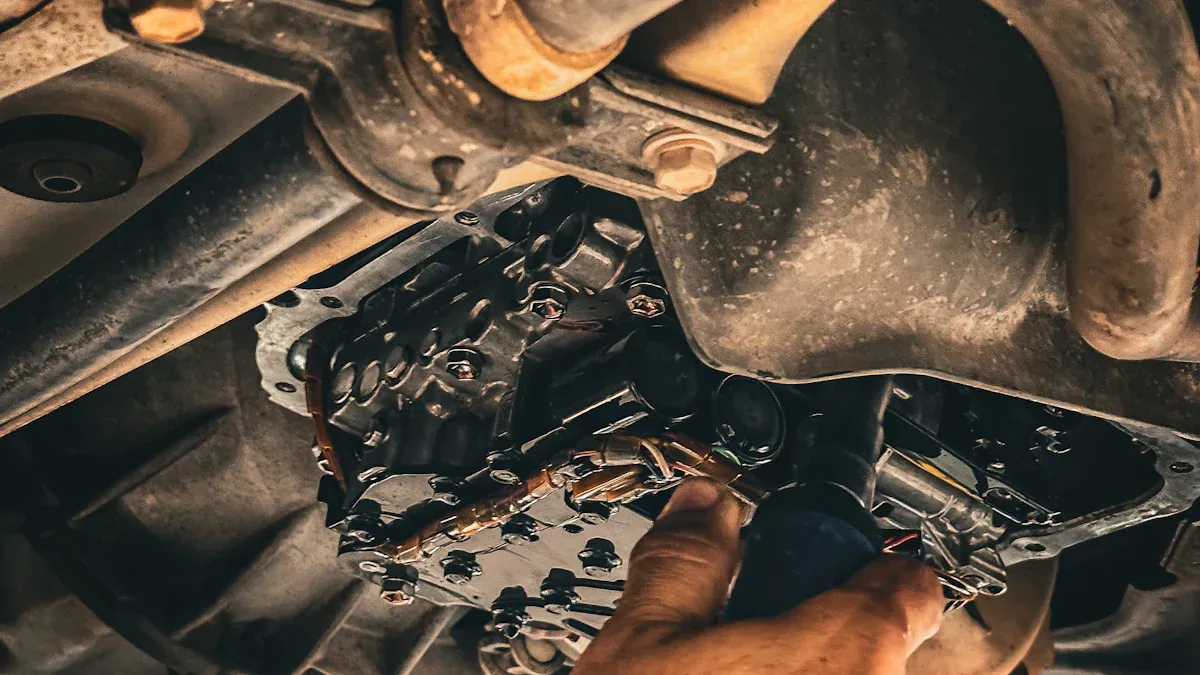
Powertrain repair costs can significantly impact your wallet, often representing a large part of your total vehicle maintenance expenses. You need to understand these vehicle service costs. Major repair can even exceed your vehicle’s value. This guide explains what your powertrain is, why these repairs are costly, and how you manage these expenses. You should budget for potential repair needs. An ideal budget of at least $100 per month is recommended for routine maintenance and unexpected car repair. This proactive maintenance saves you money and stress from unexpected repair costs. You can avoid costly repair surprises with smart planning.
Key Takeaways
The powertrain makes your car move. It includes the engine, transmission, driveshaft, axles, and differential.
Powertrain repairs can be expensive. This is due to complex parts, your car’s age, and labor costs.
Watch for warning lights, strange noises, or fluid leaks. These signs mean your powertrain needs attention.
Regular oil changes and following your car’s maintenance schedule save money. They prevent big repairs.
Save money for car repairs. An emergency fund helps you pay for unexpected costs.
Understanding the Powertrain

Defining Key Components
The powertrain is the heart of your vehicle. It generates power and delivers it to the wheels. You rely on it for every drive. Understanding its parts helps you understand your car. The powertrain includes several key components:
Engine: This is the core power generator. It converts fuel into motion. The engine turns linear piston motion into rotational motion. A crankshaft helps with this process.
Transmission: This component adjusts engine power. It transfers power to the wheels. It does this based on your driving conditions.
Driveshaft: This part transmits torque. Torque moves from the transmission to the wheels. It handles different angles and lengths. This happens because of suspension movement.
Axles: Axles support your vehicle’s weight. They rotate to deliver engine power to the wheels.
Differential: You find the differential within the rear axle. It allows each rear wheel to spin at different speeds. This is important when you turn.
Powertrain’s Role in Vehicle Function
The powertrain makes your vehicle move. It converts power into the rotation of your wheels. The engine, transmission, differential, and drive axle assemblies all work together. Electronic control systems also play a role. These systems regulate performance, fuel economy, and emissions. Your powertrain’s main job is to propel your vehicle. It helps you drive at your desired speeds. It directs engine power to the tire contact patches. This gives you effective motion control.
Modern vehicles, especially those with energy recovery systems, use the powertrain differently. It manages power flow in two directions. It works with braking systems. This allows for energy storage and recovery. This design uses more than one power source. It also has multiple operating modes. The powertrain delivers power and stores it. This maximizes the benefits of energy recovery. It even influences the size of components like batteries. This helps with faster charging during braking.
Factors Affecting Powertrain Repair Costs
Many elements influence your powertrain repair costs. Understanding these factors helps you prepare for potential expenses. You can make informed decisions about your vehicle’s care.
Component Complexity and Cost
The complexity of a powertrain component directly impacts its repair cost. Modern vehicles use intricate systems. These systems require specialized tools and highly skilled technicians. This drives up the price of any necessary repair. For example, consider these common powertrain repairs:
Powertrain Component | Average Repair Cost | Factors Influencing Cost |
|---|---|---|
Engine Rebuild | $4,000 – $7,000 | Specialized equipment, skilled labor, intricate engine design, complete disassembly, component inspection, replacement of worn parts |
Transmission Repair | $1,800 – $3,400 | Complexity of work, highly skilled technicians, specialized parts (especially for luxury/imported vehicles) |
Transmission Replacement | Up to $8,000 | Vehicle model and make, need for full replacement versus repair, specialized parts and labor |
An engine rebuild involves many steps. It requires specialized equipment and skilled labor. A transmission repair also demands highly skilled technicians. These complex jobs lead to higher repair costs.
Vehicle Make, Model, and Age
Your vehicle’s make, model, and age significantly affect repair expenses. Luxury vehicles often have higher repair costs. They use specialized parts and advanced technology. Specific powertrain types also matter. Hybrid or electric vehicle (EV) powertrains can have different repair needs than traditional internal combustion engine (ICE) vehicles. As your car ages, its components wear out. This increases the likelihood of major auto repair issues. Older cars often need more frequent and expensive repairs.
Labor Rates and Shop Type
Labor costs are a big part of your total repair bill. These costs reflect the technician’s time and expertise. Shops calculate them hourly or through flat-rate systems. Technician wages, shop overhead, and certifications all impact these rates. For instance, ASE-certified mechanics often charge 10–20% more per hour. They have advanced expertise. Shops with advanced diagnostic equipment also factor these costs into their rates.
Different types of shops charge different labor rates:
Shop Type | Specialization | Typical Labor Rates |
|---|---|---|
In-and-Out Lube Shops | Quick oil changes, essential maintenance | Generally lower |
General Repair Shops | Various repairs, routine to complex diagnostics | Vary widely |
Specialty Shops | Transmissions, brakes, performance modifications | Often higher |
Dealership Service Centers | Specific vehicle brands, original parts, specialized equipment | Typically higher |
Performance and Customization Shops | Modifications, performance upgrades | Typically higher |
You will find higher rates at specialty shops or dealerships. They offer specialized knowledge and parts.
Damage Severity and Parts Choice
The extent of damage directly impacts your repair costs. A minor issue costs less to fix than a major component failure. Your choice of parts also affects the price. Original Equipment Manufacturer (OEM) parts match your car’s original specifications. They often cost more. Aftermarket parts can be cheaper. They may not always offer the same quality or fit. You must weigh cost against quality when you choose parts for any repair.
Common Powertrain Repairs and Costs

You need to know about common powertrain repairs and their costs. This helps you prepare for potential expenses. Understanding these repairs can save you money and stress.
Engine Repair Examples
Your engine is vital. It powers your vehicle. Engine problems can be very expensive.
A common engine problem is a failing head gasket. This part seals the engine’s combustion chambers. A professional head gasket repair can cost a lot.
Professional Head Gasket Repair:
Labor Costs: Expect 6 to 12 hours at $75 to $200 per hour.
Parts Costs: Parts range from $100 to $500. Luxury or high-performance cars may cost more.
Total Estimate: A standard vehicle repair costs $1,000 to $3,000. High-performance or luxury vehicles can cost $3,000 to $5,000.
You can try a DIY head gasket repair. This involves buying parts and tools.
DIY Head Gasket Repair (Full Replacement):
Parts: $100 to $500.
Tools: Renting tools costs $50 to $100. Buying them costs $200 to $500.
Additional Costs (fluids): $50 to $100.
Total Estimate: $200 to $700 (not counting your time).
Several factors influence these repair costs. Larger engines or performance engines cost more. Original Equipment Manufacturer (OEM) parts are pricier than aftermarket options. Labor costs are a big expense. They change based on your location and mechanic rates. Fixing a failing head gasket early is cheaper than waiting for a complete failure.
Skipping regular maintenance, like an oil change, causes severe engine damage. This is one of the most damaging mistakes. It often leads to complete engine failure. When this happens, you face a costly engine rebuild or replacement. These options cost much more than routine maintenance.
Neglecting regular oil change services leads to big financial burdens. You might need expensive engine repairs or even a full engine replacement. Clean oil provides proper lubrication. Without it, friction and overheating damage critical engine parts. Pistons or bearings can suffer significant damage. The cost to repair or replace these parts can be thousands of dollars. This sometimes exceeds an older vehicle’s value. You might even need to buy a new car.
Here are typical costs for engine damage:
Repair Type | Average Cost |
|---|---|
Routine oil change | $30-$75 |
Engine flush | $100-$200 |
Engine rebuild | $2,500-$4,500 |
Engine replacement | $4,000-$7,000+ |

Overheating damage can also lead to significant expenses. This type of damage can cost $1,500 to $5,000 to fix. These are serious auto repair issues.
Transmission Repair Examples
Your transmission manages power from the engine to the wheels. Transmission problems can be complex and costly.
A transmission fluid flush replaces old fluid with new fluid. A special machine does this. This service typically costs between $375 and $600. A simpler fluid change costs $75 to $150.
Shift solenoids are crucial for gear changes. Replacing a single shift solenoid can range from $300 to $700. The cost increases if you need multiple solenoids. Minor repairs, like a transmission fluid leak or solenoid replacement, cost $150 to $400.
For more extensive issues, you might need a transmission rebuild or replacement.
Transmission Rebuild: This costs $2,000 to $5,000.
Transmission Replacement: This is one of the most expensive repairs. Average costs range from $1,800 to $6,500. Labor alone can be $740 to $3,330 for 4 to 18 hours of billed time. Total costs can reach $3,500 to $8,000 or more.
Drivetrain Repair Examples
The drivetrain sends power from the transmission to the wheels. It includes several key components.
Differential repairs can be quite costly. Replacing differential bearings typically ranges from $200 to $500. A complete differential rebuild or replacement can cost between $1,000 and $3,000.
Replacing a driveshaft generally costs between $500 and $1,000. U-joint repairs or replacements average $200 to $300. A front driveshaft replacement costs $300 to $1,000. Labor alone for this can be $300 to $1,000. The overall cost for a driveshaft replacement at most shops is around $400 to $1,000. It can range from $300 to $1,500. This depends on the service location, vehicle model, year, and mileage.
For CV joints, replacement usually costs $200 to $400 per axle. If the entire axle needs replacement, the cost can be $300 to $800. Axle shaft replacements cost about $100-$250 each for parts. Labor for replacement adds $150-$400.
Hybrid/EV Powertrain Specifics
Hybrid and electric vehicles have unique powertrain components. These include batteries, electric motors, and inverters. Repairs for these parts can be very specialized.
A Powertrain Control Module (PCM) replacement is another common repair. The PCM is your vehicle’s computer. It controls many engine and transmission functions. The average cost for a PCM replacement is $1,063 to $1,164. This includes parts and labor. These specific auto repair issues highlight the complexity of modern vehicles.
Understanding these common powertrain repair costs helps you budget effectively.
Signs of Powertrain Trouble
You need to recognize the signs of powertrain trouble early. This helps you avoid more expensive repairs. Your vehicle often gives you clues when something is wrong.
Warning Lights and Indicators
You see warning lights on your dashboard. These lights signal potential powertrain problems. The Check Engine Light illuminates. A sensor detects an engine problem. This could be a minor issue like a spark plug fault. It could also be a major problem such as an intake manifold failure. You should have a trusted mechanic address this promptly. Ignoring it can lead to further complications.
Other important indicators include:
Transmission Temperature: This light shows an overheated transmission. Low fluid levels or excessive wear can cause this. You should pull over to cool down the transmission. Seek mechanic assistance if the issue continues.
Coolant Temperature: This light looks like a thermometer in water. It signals excessive engine temperatures. A broken water pump, low coolant, or a hose leak can cause this. Ignoring it leads to serious engine problems.
Reduced Power Warning: This light means your engine computer has limited the engine’s power.
Powertrain Fault: This light comes on when the powertrain or All-Wheel Drive (AWD) system has a fault.
Unusual Noises and Vibrations
You might hear strange noises or feel vibrations. These indicate powertrain trouble. Listen for specific sounds:
Clunking, whining, or grinding sounds when you shift gears. You might also hear them while driving. These sounds can point to issues with your transmission. They can also signal problems with the differential or universal joints.
You might feel excessive vibrations or shaking. These can be in your steering wheel, floorboards, or seats. Worn-out or damaged drivetrain components cause these. Examples include the driveshaft, CV joints, or wheel bearings.
A shudder that changes with vehicle speed might mean a locked-up torque converter. A vibration that varies with engine speed could be a broken motor mount. These signs need prompt repair.
Performance Issues
Your vehicle’s performance can change. These changes suggest powertrain problems. You might notice poor performance. This includes a lack of power. You might have slow acceleration. You could also have difficulty maintaining speed. These issues point to problems within your car’s systems. The electrical or fuel system could be at fault.
Your fuel economy might decrease. You fill up your gas tank more often. This could be due to a failing oxygen sensor. Dirty intake valves or fuel system issues can also cause it. These problems lead to inefficient fuel combustion. You might experience diminished acceleration. Your vehicle struggles to gain speed. This is noticeable on highways. Irregular performance can also occur. Your car might idle erratically. It might also have difficulty maintaining consistent speeds. These issues often come with unusual noises.
Fluid Leaks
You might see fluid puddles under your car. These are clear signs of powertrain trouble. Different fluids indicate different problems. Red or brown fluid often means a transmission fluid leak. This can lead to serious transmission repair needs. Dark brown or black fluid could be engine oil. An engine oil leak needs immediate attention. Green, orange, or pink fluid is usually coolant. A coolant leak can cause your engine to overheat. You should identify the source of any leak quickly. Address it to prevent further damage and costly repair. These are serious auto repair issues.
Preventative Maintenance
Prevention is key. You can avoid major repairs that can exceed your vehicle’s value. Proactive care keeps your car running well. It also saves you money.
Regular Fluid Services
Regular fluid services are crucial for preventing costly repair. You must change your engine oil. Most vehicles need an oil change every 3,000 to 5,000 miles. Some cars can go 7,000 or 8,000 miles. Dirty oil increases friction. This causes wear and tear on engine parts. Most manufacturers recommend motor oil changes every 5,000 to 10,000 miles. Some even extend to 15,000 miles.
You also need to change your transmission fluid. This typically happens every 100,000 to 150,000 miles. This depends on your car and driving conditions. Some manufacturers suggest changes between 30,000 and 60,000 miles. Newer vehicles with synthetic fluids might allow longer intervals. Frequent towing or hot weather driving means you need more frequent servicing.
Coolant and radiator fluid also need attention. You should change them every 30,000 to 50,000 miles. Degrading coolant becomes acidic. It corrodes parts, especially aluminum. It also loses its ability to absorb heat. This can cause engine overheating and failure. Engine coolant is generally advised every 24 to 36 months. This varies with operating conditions. These routine oil changes and other fluid services are vital for your car’s health.
Following Manufacturer Schedules
You must follow your car’s manufacturer maintenance schedule. This schedule outlines all necessary services. It tells you when to perform them. These services include inspections, fluid changes, and part replacements. Following this schedule helps you catch small issues early. It prevents them from becoming expensive repairs. This proper maintenance extends your vehicle’s life.
Gentle Driving Habits
Gentle driving habits reduce stress on your powertrain. They promote vehicle longevity. Avoid rapid acceleration. It stresses the engine and drivetrain. Gradual speed increases promote efficiency. They reduce strain on components. Smooth shifts actively decrease premature wear on essential car parts. Consistent driving, avoiding abrupt starts and stops, extends car lifespan. It reduces engine strain and mechanical issues. This preventative maintenance helps you avoid costly repair.
Budgeting for Powertrain Repair Costs
You need a smart financial plan for your vehicle. This plan helps you manage unexpected expenses. Powertrain repair costs can be significant. You can avoid financial stress with proper budgeting.
Emergency Fund for Repairs
You should always set aside money for vehicle maintenance expenses. Budgeting at least $100 per month is a good starting point. This money covers routine maintenance and unexpected repairs. Your average annual costs can range from $900 to $1,452 if you drive about 15,000 miles. These costs vary widely by car brand. Luxury vehicles often have higher repair costs. An emergency fund ensures you are ready for major auto repair issues. This proactive approach saves you from sudden financial burdens.
Extended Warranty Considerations
You might consider an extended warranty for your powertrain. These warranties cover major systems like the engine and drivetrain components. This includes the transmission, axles, and differential. They can offer peace of mind. You know major repairs are covered. This reduces stress during vehicle ownership.
However, you must weigh the pros and cons carefully.
Pros of Extended Powertrain Warranty:
Potential Savings: You could save a lot of money if you need major repairs for high-cost parts. This includes the engine or transmission.
Convenience and Added Benefits: Many warranties include perks. These can be roadside assistance, rental car coverage, and trip interruption benefits.
Transferability: A transferable warranty can increase your car’s resale value.
Cons of Extended Powertrain Warranty:
Upfront Cost: These warranties can be expensive. You might never use it.
Limited Coverage: Warranties often have exclusions. They might not cover all types of repair. You must review the terms carefully.
Claim Disputes: You might have disagreements about coverage.
Reliability Factor: Modern vehicles are often reliable. The warranty might be unnecessary.
Overlap: Your extended warranty could overlap with the manufacturer’s warranty. This leads to redundant coverage.
Depreciation: As your car ages, expensive repairs might not make financial sense. Replacing the vehicle could be a better option.
Extended car warranties typically cover your car’s powertrain after the standard manufacturer’s warranty ends. They address malfunctions in major systems.
These systems include the engine and drivetrain components. While some warranties focus only on the drivetrain, they generally cover the cost if a covered part breaks. You must review the fine print. Warranties may have deductibles. They might require reimbursement. They might only cover named components, excluding others. They usually do not cover damage from accidents or normal wear and tear. Extended warranties are often not cost-effective.
They have high upfront prices and coverage restrictions. It can be more economical for you to cover repair costs yourself. You could also consider alternatives like vehicle protection plans or mechanical breakdown insurance.
Powertrain coverage contracts are common. They focus on high-value replacement items. These include the engine, transmission, transfer case, and some differentials. These contracts are generally more affordable. However, they can still be costly. They often do not cover every part of a repair. For example, an engine might be covered. But fluids, hoses, and ignition parts might be your responsibility. This adds to the overall repair costs.



